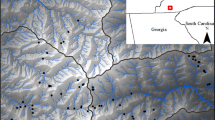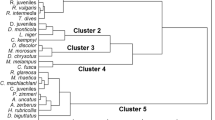Summary
Hypotheses about the influence of intraspecific density and available cover on home range size (=mean activity radius) of a plethodontid salamander (Desmognathus monticola) were tested by field experimentation from June 1980 to October 1981. A second order mountain stream in southwestern North Carolina was marked into five sections (two control and three experimental) and three replicated treatments were performed: Treatment I, low and high density additions of D. monticola; Treatment II, addition of cover objects (rocks); Treatment III, addition of cover and D. monticola.
In Treatment I, home ranges of D. monticola on high density addition plots increased significantly relative to those on control and low density addition plots. Mean stomach content biomass and number of prey items of salamanders from high density plots were less than controls in all comparisons throughout the experiment but only one comparison revealed a statistically significant difference. Mean stomach contents of salamanders from low density plots were less than controls in 60% of all comparisons and only one statistically significant difference was found. Home range size was not affected significantly by Treatments II and III.
Results of these experiments suggest that home range size of D. monticola may vary as a function of the number of conspecifics and cover objects; i.e., when the number of D. monticola increases where cover is limited, home range size increases.
Similar content being viewed by others
References
Arnold SJ (1977) The evolution of courtship behavior in new world salamanders with some comments on old world salamandrids. In: Taylor DH, Guttman SI (eds). The reproductive biology of amphibians. Plenum Press, New York, pp 141–183
Ashton RE Jr (1975) A study of movement, home range, and winter behavior of Desmognathus fuscus (Rafinesque). J Herpetol 9:85–91
Barbour RW, Hardin JW, Schafer JP, Harvey MJ (1969) Home range, movements, and activity of the dusky salamander, Desmognathus fuscus. Copeia 1969:293–297
Barthalmus GT, Bellis ED (1972) Home range, homing, and the homing mechanism of the salamander, Desmognathus fuscus. Copeia 1972:632–642
Brown JL (1975) The evolution of behavior. WW Norton, New York
Burt WH (1943) Territoriality and home range concepts as applied to mammals. J Mammal 24:346–352
Conder PJ (1949) Individual distance. Ibis 91:649–655
Dice LR, Clark PJ (1953) The statistical concept of home range as applied to the recapture radius of the deermouse (Peromyscus). Contr Lab Vert Biol Univ Mich 62:1–15
Ebersole JP (1980) Food density and territory size: an alternative model and a test on the reef fish Eupomacentrus leucostictus. Amer Nat 115:492–509
Ferner J (1974) Home range size and overlap in Sceloporus undulatus erythrocheilus (Reptilia: Iguanidae). Copeia 1974:332–337
Fitzpatrick LC (1973) Energy allocation in the Allegheny mountain salamander, Desmognathus ochrophaeus. Ecol Monogr 43:43–58
Fitzpatrick LC (1976) Life history patterns of storage and utilization of lipids for energy in amphibians. Amer Zool 16:725–732
Forsyth DJ, Smith DA (1973) Temporal variability in home ranges of eastern chipmunks (Tamias striatus) in a southeastern Ontario woodlot. Amer Midl Nat 90:107–117
Harestad AS, Bunnell FL (1979) Home range and body weight — a reevaluation. Ecology 62:65–72
Hayne DW (1949) Calculation of size of home range. J Mammal 30:1–18
Hixon MA (1980) Food production and competitor density as the determinants of feeding territory size. Amer Nat 115:510–530
Hixon MA, Carpenter FL, Paton DC (1983) Territory area, flower density, and time budgeting in hummingbirds: an experimental and theoretical analysis. Am Nat 122:366–391
Huheey JE, Brandon RA (1973) Rock-face populations of the mountain salamander, Desmognathus ochrophaeus, in North Carolina. Ecol Monogr 43:59–77
Hynes HBN, Coleman MJ (1968) A simple method of assessing the annual production of stream benthos. Limnol Oceanogr 13:569–573
Jaeger RG (1980) Fluctuations in prey availability and food limitation for a terrestrial salamander. Oecologia (Berlin) 44:335–341
Jaeger RG (1981) Dear enemy recognition and the costs of aggression between salamanders. Amer Nat 117:962–974
Jaeger RG, Barnard DE (1981) Foraging tactics of a terrestrial salamander: choice of diet in structurally simple environments. Amer Nat 117:639–664
Jaeger RG, Gergits WF (1979) Intra-and interspecific communication in salmanders through chemical signals on the substrate. Anim Behav 27:150–156
Jaeger RG, Rubin AM (1982) Foraging tactics of a terrestrial salamander — judging prey profitability. J Anim Ecol 51:161–176
Jennrich RI, Turner FB (1969) Measurement of non-circular home range. J Theor Biol 22:227–237
Keen WH (1975) Foraging strategies in two species of plethodontid salamanders. Ph D Thesis Kent State Univ Kent OH
Keen WH (1982) Habitat selection and interspecific competition in two species of plethodontid salamanders. Ecology 63:94–102
Keen WH, Sharp S (1984) Responses of a plethodontid salamander to conspecific and congeneric intruders. Anim Behav 32:58–65
Kleeberger SR (1982) An empirical analysis of competition in the salamanders Desmognathus monticola and D. quadramaculatus. Ph D Thesis Kent state Univ Kent OH
Kleeberger SR (1984) A test of competition in two sympatric populations of desmognathine salamanders. Ecology 65:1846–1856
Kleeberger SR, Werner JK (1982) Home range and homing behavior of Plethodon cinereus in northern Michigan. Copeia 1982:409–415
Kleeberger SR, Werner JK (1983) Post-breeding migration and summer movement of Ambystoma maculatum. J Herpetol 17:176–177
Laundre JW, Keller BL (1981) Home range use by coyotes in Idaho. Anim Behav 29:449–461
Maiorana VC (1977) Tail autotomy, functional conflicts and their resolution by a salamander. Nature 265:533–535
Mares MA, Lacher TE Jr, Willig MR, Bitar NA, Adams R, Klinger A, Tazik D (1982) An experimental analysis of social spacing in Tamias striatus. Ecology 63:267–272
Mares MA, Watson MD, Lacher TE Jr (1976) Home range perturbations in Tamias striatus. Oecologia (Berlin) 25:1–12
Martof BS (1953) Territoriality in the green frog, Rana clamitans. Ecology 34:165–174
Maza BG, French NR, Aschwanden AP (1973) Home range dynamics in a population of heteromyid rodents. J Mammal 54:405–425
McNab BK (1963) Bioenergetics and the determination of home range size. Amer Nat 97:133–140
Merchant HC (1970) Estimated energy budget of the red-backed salamander, Plethodon cinereus. Ph D Thesis Rutgers University
Merchant HC (1972) Estimated population size and home range of the salamanders Plethodon jordani and Plethodon glutinosus. J Wash Acad Sci 62:248–257
Myllymaki A (1977) Intraspecific competition and home range dynamics in the field vole Microtus agrestis. Oikos 29:553–569
O'Farrell TP, Olson RJ, Gilbert RO, Hedlung JD (1975) A population of Great Basin pocket mice, Perognathus parvus, in the shrub-steppe of south-central Washington. Ecol Monogr 45:1–28
Organ JA (1961) Studies of the local distribution, life history, and population dynamics of the salamander genus Desmognathus in Virginia. Ecol Monogr 31:189–220
Pianka ER (1966) Convexity, desert lizards, and spatial heterogeneity. Ecology 47:1055–1059
Schoener TW (1968) Sizes of feeding territories among birds. Ecology 49:123–141
Schoener TW (1971) Theory of feeding strategies. Ann Rev Ecol Syst 2:369–404
Schoener TW (1981) An empirically based estimate of home range. Theor Popul Biol 20:281–325
Schoener TW (1983) Simple models of optimal feeding-territory size: a reconciliation. Amer Nat 121:608–629
Schoener TW, Schoener A (1980) Density, sex ratio and population structure in some Bahamian Anolis lizards. J Anim Ecol 49:19–53
Schroder GD (1979) Foraging behavior and home range utilization of the bannertail kangaroo rat (Dipodomys spectabilis). Ecology 60:657–665
Simon CA (1975) The influence of food abundance on territory size in the iguanid lizard Sceloporus jarrovi. Ecology 56:993–998
Sokal RR, Rohlf FJ (1969) Biometry: the principles and practice of statistics in biological research. WH Freeman San Francisco
Stamps JA, Tanaka S (1981) The relationship between food and social behavior in juvenile lizards (Anolis aeneus). Copeia 1981:422–434
Tilley SG (1968) Size-fecundity relationships and their evolutionary implications in five desmognathine salamanders. Evolution 22:806–816
Tilley SG (1973) Life histories and natural selection in populations of the salamander Desmognathus ochrophaeus. Ecology 54:3–17
Wilson EO (1975) Sociobiology, the new synthesis. Belknap Press Cambridge
Author information
Authors and Affiliations
Rights and permissions
About this article
Cite this article
Kleeberger, S.R. Influence of intraspecific density and cover on home range of a plethodontid salamander. Oecologia 66, 404–410 (1985). https://doi.org/10.1007/BF00378306
Received:
Issue Date:
DOI: https://doi.org/10.1007/BF00378306




